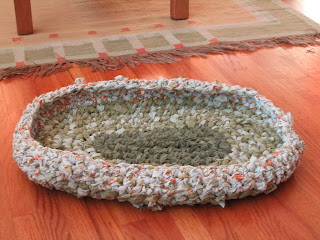My mother-in-law declutters frequently, and she usually stops by our house on her way to Goodwill to let us pick through the boxes and see if there is anything we want. Most recently, she gave us pairs of pillowcases, hand towels, and bath towels, along with pottery items that she made way back when, several cast resin bird plaques, a few pieces of old china, and some other things.
The pillowcases were black, but I soaked them in water with bleach for a few minutes, and bleached them to a dark brown. Bleaching weakens fabrics, so I didn't try for anything lighter.
The children claimed the bird plaques, but one child let me hang his in the dining room, where it fits right in and adds joy to the room.
I used some large pieces of denim that she gave me on an earlier visit to make a cover for The Wedge--a large wedge of vinyl-covered foam that appears to have been retired from service in some school phys ed program. It is very popular in our household for sliding, tipping, and fort-building, but it was very red and rather worn. I don't usually like to use denim for slipcovers, because it feels clammy without a warm body inside it, but for The Wedge this doesn't matter, and I had just enough material.
As for other projects, last weekend I got over to the ArtScraps store, and for under $4 bought some upholstery remnants (which even match!), jersey fabric, a single earring, and a medium-size piece of canvas.
I had to put some thought into how to use the upholstery fabric, which is in straight strips a few inches wide, and decided to make an ottoman or footstool. For the core of it, I am using cardboard from boxes, rolled up with the ridges running up and down. I have this step done, but I might re-roll it with more frequent creasing and tighter rolling, because the current roll is somewhat polygonal, rather than circular, and the end product is likely to be used for forts and indoor gymnastics. I actually sat in the chair that it is going to go with, and found out how high I wanted it to be by stacking books and measuring the pile; if you're going to make something for yourself, you might as well make it the perfect size.
I will be using the jersey fabric to make myself a shirt, sometime, and will probably overdye/stain it with cheap black tea, because the color is a little bright for me.
The earring is a clip-on, made of wood; I am thinking of making it into a button.
At a random rummage sale on the way home, I found an ice bucket. I was looking for one
to use as a compost bucket. We do not have a compost bin yet; I was thinking of buying a municipally-subsidized bin for $40, but after some discussion with my husband and consultation of our rummage-sale composting book, we decided to use what we have--metal garden fencing which we bought to keep our children inside our community garden plot in our days of apartment living, and then outside of our raised bed garden at the last house--and make a circular wire bin that we can take down when we move.
Also, I am making a fabric-wrapped-around-clothesline basket. One way is to use a sewing machine and sew it into a coil with a wide zigzag stitch, but I am rough enough on my machine with ordinary sewing, and I don't like the look of zigzags, so I am using the fabric to actually weave it together. I have never made one before, so it took a little experimenting at first to get the rhythm right: wrap the fabric once around the clothesline, then (using a big yarn needle) sew it to the previous round with one stitch; repeat in a spiral. This method is
much slower than zigzagging, but probably is a bit stronger.






















